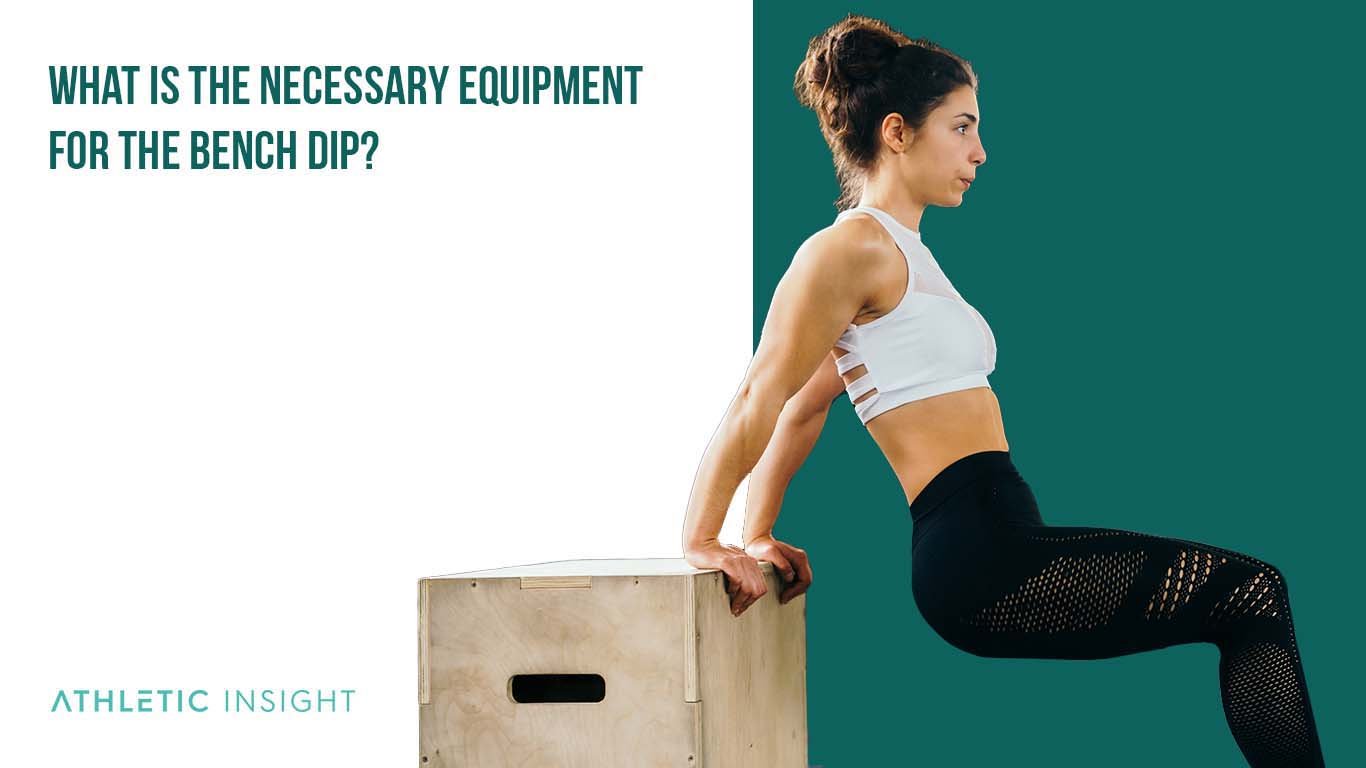Bench dips are a popular exercise that can be performed in the comfort of your own or at your local gym. A bench dip is an upper body strength training exercise that builds muscle in the pectoralis major (chest), triceps brachii (triceps), and deltoideus (shoulders).
Unlike the conventional triceps dip, bench dips, or chair dips as some refer to them as can be done without equipment. Additionally, bench dips strengthen and enhance key stabilizer muscles to improve your physical health and physique.
While the bench dip is critical for anyone looking to work out their triceps and other supporting muscles, these exercises are not to be done without utilizing the proper form. In order to prevent muscle strains and tears, it is critical that you do not; go too low, flare your elbows, go too quickly, or go too little in depth.
How to Perform Bench Dip with Proper Form?
Maintaining proper form in this triceps exercise is crucial to ensuring you get the most benefit from doing bench dips. That means hand placement, shoulder position, and not going past a certain level are vital to not getting injured and effectively working the muscles. Keep your shoulder blades right and your knuckles outward during these movements.
- Start at the edge of the bench with your hands placed next to your hips. Keep your palms down on the bench with your fingers toward the hips.
- Take a few steps forward until your hips are a few feet in front of the bench. You can keep your legs straight or bent. Make sure your shoulders are above your wrists and roll your shoulders outwards to get your lats engaged.
- Keep your chin tucked during the movement, as well as your pelvis.
- As you keep your body in this position, bend the elbows slowly and drop your hips downward until you reach a 90-degree angle with your forearms and upper arms. Pause here.
- Start to ascend by squeezing your triceps and aggressively straightening your elbows.
- Keep your elbows slightly bent once you reach the top, and continue to squeeze your triceps. You should only be moving your elbow during this exercise.
- Repeat.
What Are the Benefits of Bench Dips?
Here are some of the most common benefits of adding bench dips to your exercise regimen.

- Bench Dips Improve the Chest Strength
- Bench Dips Improve the Core Muscles of the Body
- Bench Dips Develop the Chest Aesthetic
- Bench Dips Help to Improve the Chest Muscle Endurance
- Bench Dips Improve the Shoulder Muscles, Abdominals, and Triceps
What Are the Mistakes for Bench Dip Form?
Be aware of these common yet serious benh dip mistakes that one can make when performing bench dips. Remember that slight nuances can cause injuries since the shoulders, in particular, are already in a compromised position.
- Not Low Enough. If you do not go low enough, a partial repetition does not get the triceps fully engaged, jeopardizing maximum growth. Lower until 90 degrees before rising.
- Don’t Flare Your Elbows. Do not flare the elbows outward, as it puts more tension on the shoulders instead of the triceps. This action can cause a strain or a tear during the exercise. Elbows should always be tucked.
- Don’t Go Too Low. You will put unnecessary pressure on the shoulders if you go too low during the bench dip. Remember the 90-degree rule.
- Don’t Move Too Quickly. Every movement should be slow and controlled to reap the most benefits. Going too fast and relying on mentum takes away from the necessary muscle contraction for growth and endurance.
Which Muscles Are Involved While Performing Bench Dip?
The chest works hard during a regular dip because the pectoral muscles are the primary moving component for this exercise.
The bench dip works out the same muscles as regular dips, but more of the focus is on the triceps compared to a traditional dip. The secondary muscles involved are the pectoralis, deltoids, lats, and rhomboid muscles.
What Are the Variations of Bench Dip?
The best part about exercising is that it can be done from anywhere. Often, you only need your own bodyweight to tax your muscles. If you have access to a bar or a chair, you can workout the majority of your muscles. The bench dip is one of those exercises that has many variations, where you can perform it almost anywhere, with just about anything.
The variations of the bench dip serves several purposes. It can target a specific section of the upper body that you want to focus on the variation may be a modified version that better suits your fitness capabilities or might be a variation simply because of the equipment used for the repetitions.
- Cross Bench Dip
- Reverse Chair Dip
1. Cross Bench Dip
Use two benches (or chairs) directly across from one another. Put your hands on the bench behind you and your feet on the one in front of you. Do a dip as instructed above. This focuses heavily on your core and triceps because you have to stabilize your body more without the floor beneath you.
2. Reverse Chair Dip
Use a chair to complete the dip instead of a bench. The chair might be higher than the bench, which could require the legs to stay bent instead of straight during the exercise. This will make the movement easier because you do not have to lift your total body weight. The triceps are still the most involved during this movement.
Is Bench Dip Better for Shoulders?
The bench dip primarily builds bigger and stronger triceps, and the shoulders and chest are secondary muscles that get stimulated in the process.
Based on exercises that specifically target the shoulders, the best moves for the shoulders will be the following.
- Push-Ups
- Lateral Raises
- Incline Bench Press
- Overhead Press
- Crab Walk
- Dumbbell Shoulder Push Press
What Are the Bench Dip Challenges?
You can try the one-minute bench challenge as you continue to progress and get stronger after every workout. This challenge involves doing as many bench dips (with the correct form) as possible in 60 seconds. The idea is to track your progress from week to week to see how your strength and endurance are improving.

Does Bench Dip Affect Knee and Leg Strength?
Aside from the triceps, chest, and shoulders, bench dips involve the serratus anterior, back, transverse abdominals, and glutes. These muscles provide the necessary support to go up and down. Your biceps and traps also provide stability to help your shoulders stay in the proper position.
Overall, this exercise is strictly for the upper body. There is no evidence to suggest that they affect your knee and leg strength.
What is the Necessary Equipment for the Bench Dip?
The only equipment necessary for bench dips is a bench, a chair, or a table. Other than that, because this is a bodyweight exercise, it is one of the best bench dip exercises to incorporate into your routine because it doesn’t require heavy machinery.

What Are the Bench Dip Related Facts?
- Individuals can generally lift 20 percent to 30 percent more when doing a dip than performing the bench press movement.
- The bench dip can improve a person’s ability to do a regular dip and to bench roses more effectively.
- Do not perform bench dips daily; begin with three sets of five to ten reps and move up to five sets of ten reps for strength and mass.
- Don’t overstretch (go past 90 degrees) during the movement. This does not stimulate hypertrophy but it can stress the muscles and make them go limp instead.
Does Bench Dip Affect the Hormones?
Endurance training assists with stimulating muscle growth and boosting hormones such as epinephrine, cortisol, glucagon, and glucose. In men, performing endurance exercises for too long can cause a drop in testosterone levels if done for too long.
Does Bench Dip Affect the Mood?
While there is no direct correlation to the bench dip specifically affecting mood, physical exercise does have a positive effect on mood.
Individuals that engage in regular physical activity have better emotional well being and mental health. Chemicals in the brain like serotonin, endorphins, stress hormones, and more, change as you exercise. These hormones are responsible for happiness and stress relief.
Is Bench Dip a Military Movement?
The Special Operations Fitness Test does consist of a minimum of six untimed dips to pass the Upper-Body Round Robin skills assessment. For this test, the elbows must form a 90-degree angle for each repetition to count.
Is Bench Dip Push or Pull?
A pushing exercise involves all movements that cause the individual to push their weight away from their body. When performing a bench dip, the arms get pushed upward. Any movement that engages the triceps, shoulders, and chest is a push exercise.
Is Bench Dip Essential?
Bench dips are effective but not necessarily essential when you decide on a workout regimen. This movement is a complementary exercise that can have immense benefits on other workouts and critical stabilizing muscles.
What Can Replace Bench Dip?
An effective bench dip alternative accomplishes two things.
- Targets and isolates similar muscles as the bench dip does.
- Strengthens and enhances the pressing ability of the triceps and chest muscles.
There are several alternatives that will efficiently work out the same muscles used during a bench dip, but here are three of the most popular alternatives.
- Diamond Push Up
- Decline Bench Press
- Close Grip Bench Press
What is the difference between a Bench Dip and a Tricep Dip?
A bench dip is a tricep exercise that is done with a bench, but it can also be completed with any stationary object (like a chair). The bench dip is a well known exercise that can be completed with minimal equipment and in addition to the triceps, the movement can sometimes work the shoulders as well.
A tricep dip is a common exercise seen performed in most gyms that is done with a dip bar. These dip exercises work the triceps, chest, back and shoulders. Not only does the tricep dip tax other muscles, but there are many variations that can be utilized.



